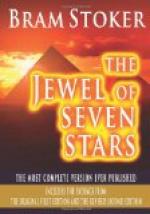of symbol or ornamentation of any kind. At the
first glance this would seem to imply that the drawings
had been made after the sarcophagus had been put into
its place. But a more minute examination will
show that the symbolisation on the floor is so arranged
that a definite effect is produced. See, here
the writings run in correct order as though they had
jumped across the gap. It is only from certain
effects that it becomes clear that there is a meaning
of some kind. What that meaning may be is what
we want to know. Look at the top and bottom of
the vacant space, which lies West and East corresponding
to the head and foot of the sarcophagus. In
both are duplications of the same symbolisation, but
so arranged that the parts of each one of them are
integral portions of some other writing running crosswise.
It is only when we get a coup d’oeil from either
the head or the foot that you recognise that there
are symbolisations. See! they are in triplicate
at the corners and the centre of both top and bottom.
In every case there is a sun cut in half by the line
of the sarcophagus, as by the horizon. Close
behind each of these and faced away from it, as though
in some way dependent on it, is the vase which in
hieroglyphic writing symbolises the heart—’Ab’
the Egyptians called it. Beyond each of these
again is the figure of a pair of widespread arms turned
upwards from the elbow; this is the determinative
of the ‘Ka’ or ‘Double’.
But its relative position is different at top and
bottom. At the head of the sarcophagus the top
of the ‘Ka’ is turned towards the mouth
of the vase, but at the foot the extended arms point
away from it.
“The symbolisation seems to mean that during
the passing of the Sun from West to East—from
sunset to sunrise, or through the Under World, otherwise
night—the Heart, which is material even
in the tomb and cannot leave it, simply revolves,
so that it can always rest on ‘Ra’ the
Sun-God, the origin of all good; but that the Double,
which represents the active principle, goes whither
it will, the same by night as by day. If this
be correct it is a warning—a caution—a
reminder that the consciousness of the mummy does
not rest but is to be reckoned with.
“Or it may be intended to convey that after
the particular night of the resurrection, the ‘Ka’
would leave the heart altogether, thus typifying that
in her resurrection the Queen would be restored to
a lower and purely physical existence. In such
case what would become of her memory and the experiences
of her wide-wandering soul? The chiefest value
of her resurrection would be lost to the world!
This, however, does not alarm me. It is only
guess-work after all, and is contradictory to the
intellectual belief of the Egyptian theology, that
the ‘Ka’ is an essential portion of humanity.”
He paused and we all waited. The silence was
broken by Doctor Winchester:
“But would not all this imply that the Queen
feared intrusion of her tomb?” Mr. Trelawny
smiled as he answered:




